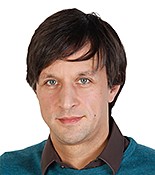Specialized iNANO Lecture: Advances in segmented helical reconstruction
Dr. Carsten Sachse, PhD Group leader at EMBL Heidelberg, Heidelberg, Germany
Info about event
Time
Location
iNANO AUD (1593-012), Gustav Wieds Vej 14, 8000 Aarhus C

Dr. Carsten Sachse, PhD, Group leader at EMBL Heidelberg, European Molecular Biology Laboratory, Structural and Computational Biology Unit,Heidelberg, Germany
Advances in segmented helical reconstruction Advances in segmented helical reconstruction
As a result of recent advances in software and hardware, cryo-EM based structure determination in near native condition is currently undergoing a ‘resolution revolution’ in structural biology. In my talk, I will present our efforts on the structure elucidation of helical assemblies [1] as they present a fundamental architecture of structures involved in diverse cellular processes such as cytoskeleton assembly, endocytosis, signaling and autophagy. In my talk, I will provide an overview to segmented helical reconstruction covering the entire structure determination workflow from symmetry analysis to high-resolution structure refinement [2].
Further, I will illustrate based on previous and more recent examples of how direct electron detector technology and image processing have contributed to helical reconstruction [3] and have helped to reveal the functionality and versatility of helical organization for various processes in the cell. Recent developments in combining traditional Fourier-Bessel procedures with single-particle algorithms provide a versatile and comprehensive approach to structure determination of helical specimens [4].
I will present applications from a range of medium to high resolution structures. For example, we showed that autophagy receptor p62/SQSTM-1 assembles into flexible helical filaments that provide insights into the structural basis of polymer formation [5]. Recent hardware advancement by the introduction of direct electron detectors has significantly enhanced the image quality and together with improved image processing procedures has made segmented helical reconstruction a very productive cryo-EM structure determination method.
References:
- Sachse, C. Single-particle based helical reconstruction—how to make the most of real and Fourier space. AIMS Biophysics 2, 219–244 (2015).
- Fromm, S. A. & Sachse, C. Cryo-EM Structure Determination Using Segmented Helical Image Reconstruction. Meth Enzymol 579, 307–328 (2016).
- Fromm, S. A., Bharat, T. A. M., Jakobi, A. J., Hagen, W. J. H. & Sachse, C. Seeing tobacco mosaic virus through direct electron detectors. J Struct Biol 189, 87–97 (2015).
- Desfosses, A., Ciuffa, R., Gutsche, I. & Sachse, C. SPRING - an image processing package for single-particle based helical reconstruction from electron cryomicrographs. J Struct Biol 185, 15–26 (2014).
- Ciuffa, R. et al. The selective autophagy receptor p62 forms a flexible filamentous helical scaffold. Cell Rep 11, 748–758 (2015).
Host: Associate professor Ebbe Sloth Andersen, iNANO & Department of Molecular Biology and Genetics, Aarhus University
